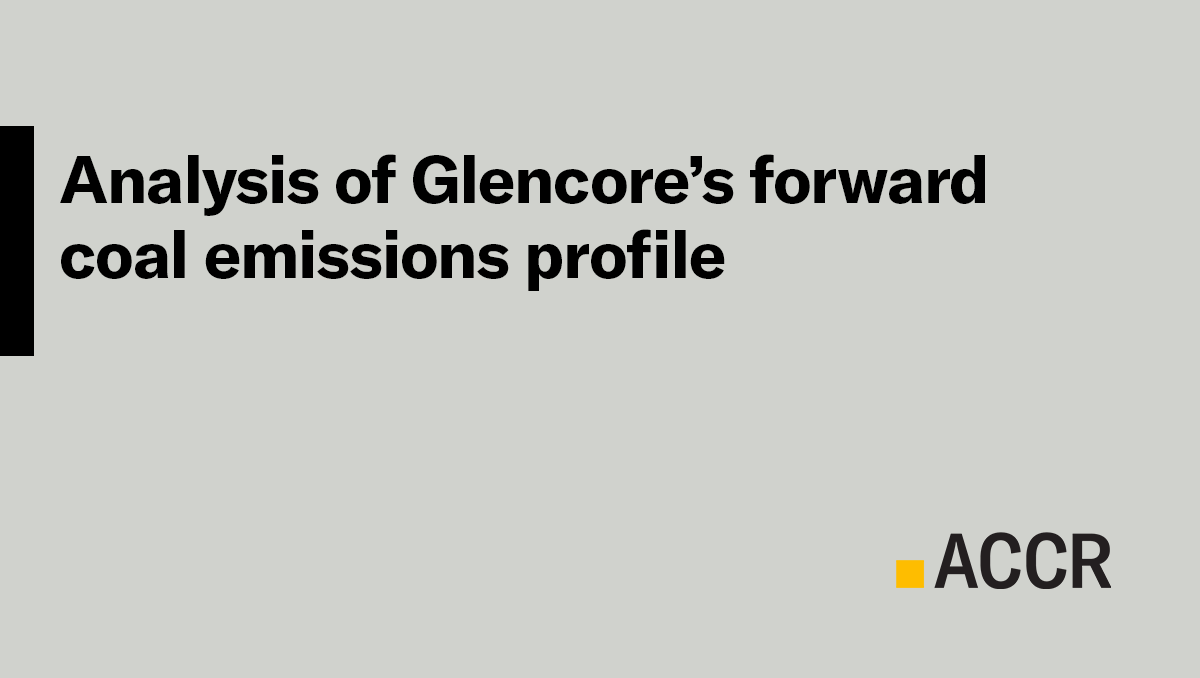Publication Analysis of Glencore’s forward coal emissions profile
This ACCR research presentation deck provides further information for investors in consideration of the 2023 shareholder resolution to Glencore plc on thermal coal production. It uses publicly available information to assess Glencore’s potential coal production against a Paris-aligned coal pathway going forward. The research also crunches the specific numbers on coal and carbon capture projects that Glencore is currently investigating.
The research shows that based on current disclosures by Glencore and its stated strategy, the company’s forecast cumulative emissions from coal production do not appear to be Paris-aligned.
Some key points from the research include:
- This research is based on public information and company disclosures available in February 2023.
- Glencore’s disclosed emissions footprint is significant at 280 Mt CO2e per annum, around 0.6% of total global emissions.
- Coal production accounts for approximately 90% of all Glencore’s CO2e emissions.
- Glencore’s ability to reach its own target of a 50% reduction in emissions by 2035 is achieved with the assistance of beneficial carbon accounting, making its emissions reductions appear more significant.*
- Despite the benefits of selecting 2019 as the base year, Glencore’s annual production from 2026 is consistently significantly above the IEA NZE coal aligned pathway.
- If Glencore proceeds with plans for the greenfield development of the Wandoan coal mine in Australia, alignment with the International Energy Agency Net Zero Emissions (IEA NZE) 2050 coal pathway does not appear feasible.
- From 2019-2050, Glencore’s cumulative coal production could be 439 Mt above the IEA NZE coal aligned pathway. Applying the current Australian national account factors, this equates to over 1 Gt CO2e, or over 2% of current global annual emissions.
- While Glencore says it is exploring the potential to reduce emissions associated with Wandoan coal by using carbon capture and storage (CCS) to sequester emissions, to fully sequester all its emissions will require more CCS capacity than in the pipeline for coal-related capture across the entire globe in 2030.
- Analysis of proposed carbon capture projects shows they are costly, unproven on an industrial scale, and do not necessarily stop greenhouse gases being emitted. One of the proposed projects may use captured CO2 for enhanced oil recovery, which cannot be classified as CCS, since far more CO2 is emitted than sequestered.
- While this research currently outlines evidence to suggest a likely misalignment between Glencore’s forward coal production and the 2022 IEA NZE coal pathway, there are opportunities for alignment into the future.
- Current evidence suggests that shareholders would benefit from enhanced disclosure from Glencore to step out how thermal coal production can and will align with the Paris Agreement going forward.
* Before rebasing for Cerrejón, Glencore’s 2019 emissions from coal are estimated to be ~337 MtCO2e, and ~190 MtCO2e in 2035 (inc. Wandoan). This implies a 44% decline in emissions. After rebasing for Cerrejón, Glencore’s 2019 emissions from coal are estimated to be ~376 MtCO2e, and still at ~190 MtCO2e in 2035. This implies a 49% decline in emissions – roughly in-line with their 2035 target.
Emissions have been effectively increased via this acquisition, yet their emissions reductions appear to be loftier.
Download ACCR’s research deck here.
Please read the terms and conditions attached to the use of this site.
